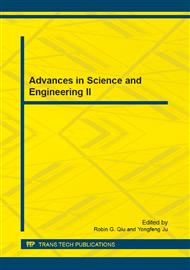[1]
K. He, W. Q. Huang, A caving degree based flake arrangement approach for the container loading problem, Computers & Industrial Engineering, vol. 59(2), p.344–351, (2010).
DOI: 10.1016/j.cie.2010.05.007
Google Scholar
[2]
T. Fanslau, A. Bortfeldt, A tree search algorithm for solving the container loading problem, INFORMS Journal on Computing, vol. 22(2), p.222–235, (2010).
DOI: 10.1287/ijoc.1090.0338
Google Scholar
[3]
K. He, W. Q. Huang, An efficient placement heuristic for three-dimensional rectangular packing, Computers & Operations Research 38(1), p.227–233, (2011).
DOI: 10.1016/j.cor.2010.04.015
Google Scholar
[4]
W. Q. Huang, K. He, A caving degree approach for the single container loading problem, European Journal of Operational Research, vol. 196(7), p.93–101, (2009).
DOI: 10.1016/j.ejor.2008.02.024
Google Scholar
[5]
E. E. Bischoff, M. S. W. Ratcliff, Issues in the Development of Approaches to Container Loading, OMEGA – The International Journal of Management Science, vol. 23(4), p.377–390, (1995).
DOI: 10.1016/0305-0483(95)00015-g
Google Scholar
[6]
T. H. Loh, A. Y. C. Nee, A packing algorithm for hexahedral boxes, Proceedings of the Industrial Automation 92 Conference, p.115–126. Singapore: Industrial Automation Association, (1992).
Google Scholar
[7]
H. Gehring, A. Bortfeldt, A genetic algorithm for solving the container loading problem, International Transactions in Operational Research, vol. 4, p.401–418, (1997).
DOI: 10.1111/j.1475-3995.1997.tb00095.x
Google Scholar
[8]
A. Bortfeldt, H. Gehring, Applying tabu search to container loading problems, Operations Research Proceedings 1998, p.533–538. Zurich: Springer, (1998).
DOI: 10.1007/978-3-642-58891-4_84
Google Scholar
[9]
A. Bortfeldt, H. Gehring, A hybrid genetic algorithm for the container loading problem, European Journal of Operational Research, vol. 131, p.143–161, (2001).
DOI: 10.1016/s0377-2217(00)00055-2
Google Scholar
[10]
H. Gehring, A. Bortfeldt, A Parallel Genetic Algorithm for Solving the Container Loading Problem, International Transactions in Operational Research, vol. 9(4), p.497–511, (2002).
DOI: 10.1111/1475-3995.00369
Google Scholar
[11]
A. Bortfeldt, H. Gehring and D. Mack, A parallel tabu search algorithm for solving the container loading problem, Parallel Computing, vol. 29(5), p.641–662, (2003).
DOI: 10.1016/s0167-8191(03)00047-4
Google Scholar
[12]
D. Mack, A. Bortfeldt and H. Gehring, A parallel hybrid local search algorithm for the container loading problem, International Transactions in Operational Research, vol. 11(5), p.511–533, (2004).
DOI: 10.1111/j.1475-3995.2004.00474.x
Google Scholar
[13]
A. Lim, B. Rodrigues and Y. Yang, 3-D Container Packing Heuristics, Applied Intelligence, vol. 22(2), p.125–134, (2005).
DOI: 10.1007/s10489-005-5601-0
Google Scholar
[14]
A. Moura, J. F. Oliveira, A GRASP approach to the container-loading problem, IEEE Intelligent Systems, vol. 20(4), p.50–57, (2005).
DOI: 10.1109/mis.2005.57
Google Scholar
[15]
E. E. Bischoff, Three-dimensional packing of items with limited load bearing strength, European Journal of Operational Research, vol. 168, p.952–966, (2006).
DOI: 10.1016/j.ejor.2004.04.037
Google Scholar
[16]
F. Parreño, R. Alvarez-Valdes, J. M. Tamarit and J. F. Oliveira, A maximal-space algorithm for the container loading problem, INFORMS Journal on Computing, vol. 20(3), p.412–422, (2008).
DOI: 10.1287/ijoc.1070.0254
Google Scholar
[17]
F. Parreño, R. Alvarez-Valdes, J. F. Oliveira and J. M. Tamarit, Neighborhood structures for the container loading problem: a VNS implementation, Journal of Heuristics, vol. 16(1) , p.1–22, (2010).
DOI: 10.1007/s10732-008-9081-3
Google Scholar
[18]
J. Terno, G. Scheithauer, U. Sommerweiß and J. Riehme, An efficient approach for the multi-pallet loading problem, European Journal of Operational Research, vol. 123, p.372–381, (2000).
DOI: 10.1016/s0377-2217(99)00263-5
Google Scholar
[19]
M. Eley, Solving container loading problems by block arrangement, European Journal of Operational Research, vol. 141, p.393–409, (2002).
DOI: 10.1016/s0377-2217(02)00133-9
Google Scholar
[20]
Z. J. Wang, K. W. Li and J. K. Levy, A heuristic for the container loading problem: a tertiary-tree-based dynamic space decomposition approach, European Journal of Operational Research, vol. 191(1), p.86–99, (2008).
DOI: 10.1016/j.ejor.2007.08.017
Google Scholar


